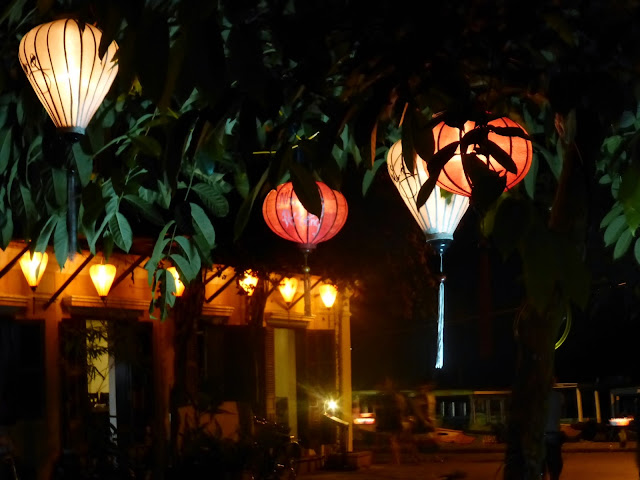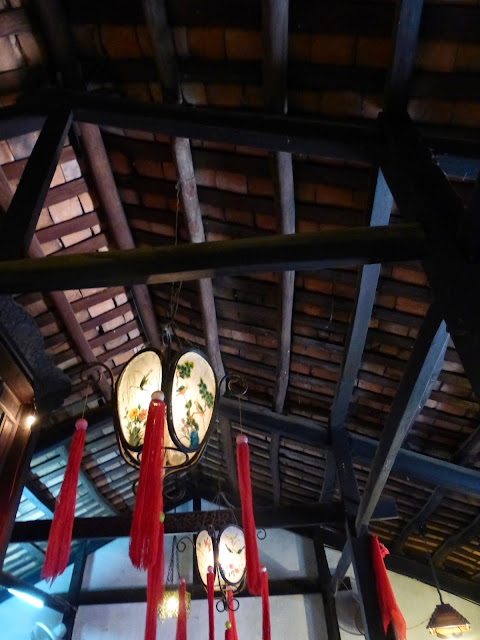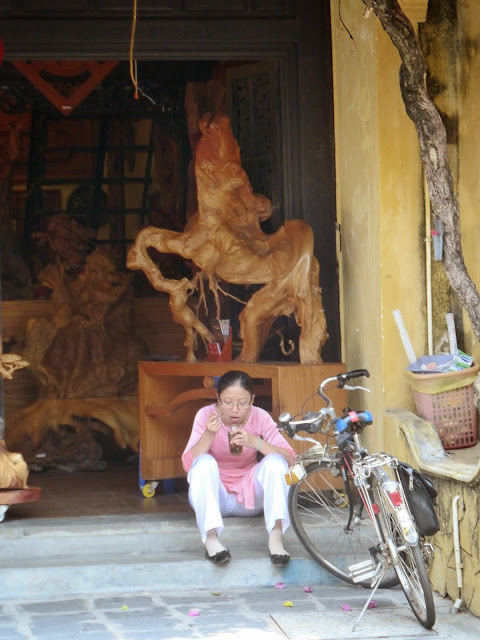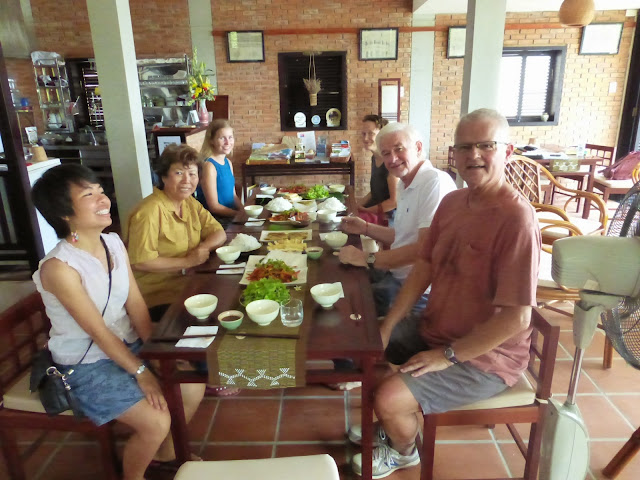Hoi An is a preserved city, on UNESCO's list of heritage sites. The old city is free of cars, buses and trucks, but not motorbikes. One of its enduring symbols is the Japanese Bridge which is called that because it was once the entrance to the Japanese section of the city.
Houses on the far side of the river are not protected but this close they still use the same colours and styles as the mouldering old buildings of the Old City. This fish trap is one of several on the river. On the right women do their morning exercise.
This woman was getting her exercise by washing her clothes using a hand-operated pump.
There are many many vendors, but the fruit sellers were my favourites. They all sold the same things and were not aggressive like some. Just a simple "bananas?". This quartet had stopped for a chance to chat, maybe to gossip.
There were a lot of offerings out on the streets because it was the time of the spring full moon, an auspicious event. In fact it is also the beginning of the New Year in Cambodia, but not Vietnam whose New Year is celebrated earlier during Tet which is in Late January or early February.
This motorbike had a child seat.
And this child was already learning to navigate the waterways.
There are narrow alleys throughout Hoi An.
This fisherman was mending his nets. It's a lot like knitting.
As always there is a lot of activity on the river.
The eyes painted on the boats are meant for protection.
I can't resist a reflection.
And even the boats need a gas station.
Note the wooden supports along the bank. Most of the boats had these - akprecarious way to get to your boat from shore.
One of the beauties of Hoi An is the lighting. The lanterns are made here; you can even take a class to make your own, and at night they add such atmosphere to the city streets.These children are just two of many many people who sell these small candle lanterns to tourists who then lower them on long poles and let them float on the river. I just think of all the garbage it produces. And apparently the children make very little money becuase they work for a gang who take most of the profit. Sigh!
There are at least sixteen old houses and temples that can be visited using a multi-visit ticket that can be used over three days. These are often still in the same family that has been living in the house, since the 1600's in some cases. They are and must be preserved and cared for as part of the UNESCO heritage designation.
Someone is always around to tell you about the houses. The roofs usually have three different architectural styles incorporated - Vietnamese, Japanese and Chinese.
This is a kitchen in the back of one of the houses. It's still in use because people do live here.
The temples are often, if not always, Chinese. The Chinese had a huge influence on this area of Vietnam and tend to marry within their own culture. One of the temples we visited was Fujian, an ethnic area of China.
Always exuberant decoration on the temple roof lines.
And dragons figure prominently in the decoration.
In the interior, these are inscence coils hanging from the ceiling in front of a very impressive and expressive porcelain mural.
I wish I knew what this said. Anyone read Chinese characters? It looks like a deer, but I'm sure that's not what it signifies.
Here's another for my Chinese reading friends to interpret.
This crane was about four feet tall.
And joss sticks are available for the devout to light as well.
Back on the streets one sees old doors that with age have taken on an abstract beauty.
And the intensity of colour is wonderful.
This woman was having lunch on front of her shop with this amazing carved figure - a horse escaping the roots of a tree?
Kites for sale.
We had tea and coffee in this unique cafe. All the staff are deaf or deaf mutes and all the ordering is done with notes and pencils. It's a quiet refuge from the noise of the street.
Here's an idea for all of you this summer. Make the ice cubes for your iced coffee with coffee! The little squiggles on the plate are flavoured coconut strips. The brown ones were coffee and the green one peeking out behind the furled chip was mint. The brass object on the left is the Vietnamese coffee dripper which are usually a more prosaic aluminum.
The service was lovely. Look at those gorgeous sugar bowls and the tea pot with their gold trimmed edges. And note the tray with the words on it. A simple way to ask for things.
Here is our lovely room in Hoi An city. We had a pool on the roof too. But sadly no lift so we had to climb the four flights of stairs. And one more to the pool.
And this is the bed in our room at GreenTea Homestay where we spent three nights after our five nights in the city. Most of the pictures you saw above with boats and drying shrimp were just an alley away from here. It was much quieter and peaceful than the city, but still only a 15 minute walk from the shops and restaurants. And each day we were greeted with a different towel creation. I guess these are dinosaurs, but we also got much more recognizable rabbits and elephants.
Geordie seems to attract little friends. This curious hen found his feet fascinating. She wasn't the least interested in his head.
And this little frog came to visit twice during breakfast at the Homestay.
Sea Anemone? No, this is the centre of a lotus blossom which was one of several at the restaurant where we had lunch with Le Ly, author of the book which inspired the Oliver Stone movie Heaven and Earth.
Le Ly is the woman in gold. She had taken over the kitchen of the U Cafe on the river bank to prepare a vegetarian meal which is traditional at the full moon. Also eating with us were some women from Norway, an American man, another Vietnamese woman seen here, and the owner of the restaurant who was Japanese. After she moved to the US, Le Ly opened a Vietnamese restaurant. With the money she earned from the movie and the book, she started two foundations which support local Vietnamese people. One of the projects developed was a library of books, in English and Vietnamese, which are delivered to local schools and changed at the end of each term. She was such a lovely person, forthright and sensible. Obviously fame has not gone to her head,













































Really wonderful photos in this post. I just read about Hoi An in a list of must see fairy tale destinations.
ReplyDeleteI agree with Holli - really wonderful photos in this post. Thanks!
ReplyDelete